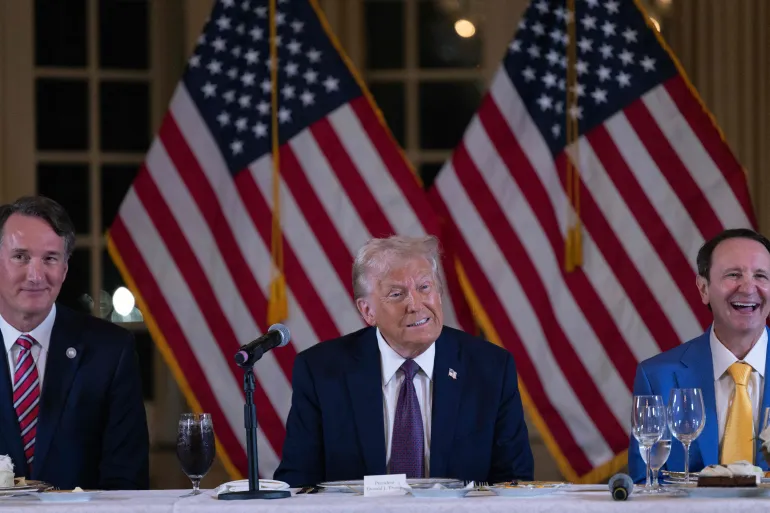By Reuters
President-Elect Trump Meets With Republican Governors At Mar-A-Lago
US President-elect Donald Trump, centre, says his incoming administration will rename the Gulf of Mexico to the Gulf of America [Scott Olson/Getty Images via AFP]
This month during a rambling news conference at his Mar-a-Lago estate, United States President-elect Donald Trump announced his latest vision for revising the map of the world: “We’re going to be changing the name of the Gulf of Mexico to the Gulf of America, which has a beautiful ring.”
He went on to reiterate approvingly: “That covers a lot of territory, the Gulf of America. What a beautiful name.”
The Gulf of Mexico, which runs along much of Mexico’s eastern coastline and abuts five southern US states, is a key international hub for shipping, fishing, oil drilling and other commercial activity. The body of water was christened as such more than four centuries ago before either the US or Mexico existed.
Of course, a unilateral renaming of the gulf by the US president would not require endorsement by Mexico or any other country. Additional cartographic adjustments recently floated by the incoming leader include seizing the Panama Canal, wresting away control of Greenland and annexing Canada.
Apart from the “beautiful ring” Trump has detected in the Gulf of Mexico’s impending new name, the proposed move is consistent with his track record of overzealous antagonism of Mexico, a country he has said is disproportionately composed of “rapists” and other criminals. And speaking of “beautiful”, Trump repeatedly demanded during his first term as president that Mexico foot the bill for the “big, beautiful wall” he envisioned erecting on the US-Mexico frontier.
Indeed, Trump viciously blames the United States’s southern neighbour for the northbound flow of “illegal” migrants and drugs – as though US demand for illicit substances and the bipartisan US habit of destroying other people’s countries have nothing to do with fuelling drug trafficking and migration. Nor, surely, does the US economic reliance on undocumented and exploitable labour play any sort of role in the equation.
Never one to pass up an opportunity for repetitive hypocrisy, Trump appended the following warning to his Gulf of Mexico announcement at Mar-a-Lago: “And Mexico has to stop allowing millions of people to pour into our country.” Anyway, the rebranding of the gulf will most certainly put the Mexicans in their place.
In the very least, the “Gulf of America” project is less invasive than previous ideas that have sprung from Trump’s brain, such as the firing of missiles at Mexico to combat the drug cartels – organisations that happen to owe their very existence to the simultaneous US demand for and criminalisation of drugs.
The hullaballoo over the renaming also provides a convenient distraction from, you know, actual problems – which is what Trump’s signature bombastic xenophobia is meant to do in the first place.
Far-right US Representative Marjorie Taylor Greene, for one, wasted no time heeding Trump’s call to arms. Just two days after the Mar-a-Lago news conference in Florida, she introduced a bill that would rename the Gulf of Mexico in accordance with the president-elect’s wishes.
As per the political website The Hill, the bill “would direct the chair of the Board on Geographic Names under the secretary of the Interior to rename all federal documents and maps within 180 days of being signed into law”. Greene added her own convincing sales pitch: “It’s our gulf. The rightful name is the Gulf of America, and it’s what the entire world should refer to it as.”
As it turns out, this is not the first time that US politicians have suggested renaming the Gulf of Mexico. An Associated Press article recalls an episode in 2012 when a member of the legislature of the state of Mississippi put forth a bill to assign the name “Gulf of America” to portions of the body of water touching Mississippi beaches – “a move the bill author later referred to as a ‘joke’”.
Meanwhile, quite a bit further back on the regional timeline, the Gulf of Mexico played host to another egregious example of imperial hubris that transpired in 1914 on the watch of Democratic US President Woodrow Wilson. The website of the Woodrow Wilson Presidential Library and Museum has memorialised that year’s “Incident at Tampico”, named for the port city in the Mexican state of Tamaulipas on the Gulf of Mexico where “American warships were sitting just off the coast to protect American oil interests.”
The previous year, a coup against Mexican President Francisco I Madero had taken place with assistance from the then-US ambassador to Mexico, producing the reign of General Victoriano Huerta. By 1914, the new US ambassador to Mexico was backing the opposition to Huerta, whose forces had the audacity to detain nine US sailors while the fleet of American warships continued to sit innocently off the coast.
In the version of the incident provided by the Woodrow Wilson Presidential Library and Museum, “the commander of US forces in the area demanded a 21-gun salute and an apology from Huerta after the sailors were quickly released”. The Mexican government rejected these demands, “and President Wilson used the events as a reason to request permission from Congress for an armed invasion of Mexico”.
And voila: “Events soon led to the occupation of [the port city of] Veracruz by US forces.”
In other words, there are plenty of reasons folks might be opposed to renaming the Gulf of Mexico.
And while Trump’s insistence on behaving like a caricature of himself makes it easier to cast him as some sort of aberration in US foreign policy, at the end of the day, it’s imperialism plain and simple – and that is one thing you just can’t rename.
This article was first published by Aljazeera and the views expressed in this article are the author’s own and do not necessarily reflect Daily Times’ editorial stance.


